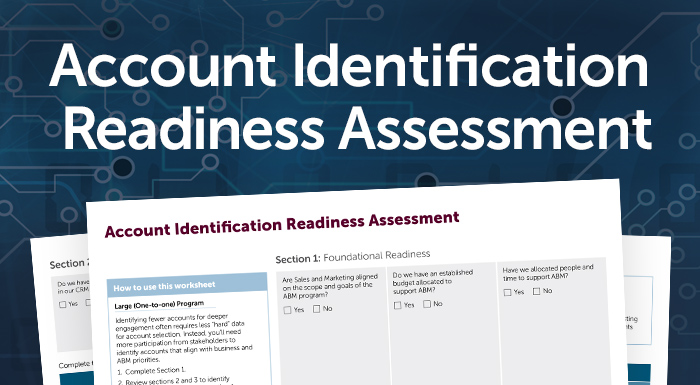Top 10 Questions from Our ABM Webinar — and Real Answers to Help You Operationalize

Share this story
During a recent webinar on how to operationalize account-based marketing (ABM), our engaged audience brought curiosity and real-world challenges to the table. Below are 10 of the most valuable questions we received — along with practical answers to help you plan, adapt and scale your ABM strategies.
1. We are new to ABM; what types of companies are using ABM successfully?
It’s less about the type of company and more about whether ABM makes sense for your business. ABM is most effective when your organization sells considered-purchase solutions (longer cycles, high value, multiple stakeholders) primarily to businesses rather than to individual consumers. That’s why ABM for B2B is so prevalent — it helps focus efforts on a specific set of high-value accounts where personalization and precision matter most.
If aligning your sales and marketing around a tiered system for ABM accounts — from one-to-one to one-to-few and one-to-many — makes sense, ABM is a strong fit.
2. Which team is typically responsible for prioritizing accounts: sales or marketing?
This depends on a few factors like your sales and marketing alignment in ABM and your chosen method for prioritizing accounts. Often, dynamic prioritization (using intent data or engagement scoring) is led by marketing, while static or tiered prioritization may be one or the other or both. The key to success is a unified strategy where both sales and marketing teams agree on account selection criteria and segmentation.
3. Can you elaborate more on what a “buying center” is? How can sales identify and tag appropriately in a CRM?
In ABM, both a “buying center” and a “buying group” refer to all stakeholders who influence or are directly involved in a purchase decision within a target account. But, there are subtle distinctions between the two. “Buying center” is a classic ABM term often implying a hierarchical organization. “Buying group” is more commonly used in campaign and tool discussions as it refers to more modern and dynamic, intent-driven engagement found in cross-functional teams.
Regardless of the terminology, understanding how an account makes purchases is important. While many CRMs track individuals via Opportunities, this data often disappears post-close. One workaround we have helped clients with is to create a custom object to house this data permanently, enabling stronger account segmentation strategies and personalization across the funnel.
4. Can you provide an example of an “account engagement score”?
An account engagement score aggregates the activities of all contacts within an account into one metric. It helps sales and marketing teams understand how their efforts were received and prioritize future activities for active and ready-to-convert accounts. While most CRMs don’t natively provide this view, many ABM platforms offer it. For instance, Engagio’s “engagement minutes” assign weighted scores to different content interactions. When used as part of your ABM measurement and ROI strategy, these scores can indicate which accounts are heating up and which need more touchpoints. Account engagement scoring is also trending toward being more customized, integrated and AI-powered, offering predictive analytics for the next-best touchpoints.
5. Do you have any economical suggestions for managing offline data and IP targeting?
Absolutely. If you are already using and paying for a marketing automation platform (MAP), it’s worth it to speak to your rep about what type of IP targeting tools they offer and their suggested options for onboarding offline data (e.g., data from in-person events, direct mail, CRM lists). If you’re using a MAP like Marketo, you may already have access to reverse IP identification — a budget-friendly option for targeted ABM campaigns. This can help identify anonymous website visitors and link them to known accounts, enriching your targeting and personalization strategies.
6. How do you assign revenue opportunities that are unique to ABM-generated accounts? Can you show an ABM strategy drives real revenue compared to non-ABM?
Yes, but it takes upfront work. You’ll need to adjust your CRM to provide an accounts-based pipeline view and distinguish between ABM and non-ABM accounts. This lets you compare performance and show tangible business impact, which is essential for proving ABM measurement and ROI.
7. We are using Salesforce as our CRM — how well will it work to support our ABM efforts?
Salesforce can indeed power an ABM marketing strategy, but it should be tailored to support account-centric workflows. To do this, use the standard Account object to represent real companies, and the Parent Account field to reflect organizational hierarchies. Segment accounts by tier, buying group, or region using custom fields or related objects to drive personalized outreach. You can tie marketing activities to accounts through campaign influence models, while engagement and pipeline impact can be tracked using custom dashboards. With this configuration, Salesforce serves as a centralized platform for targeting, activating, and measuring ABM programs at scale.
8. We have a lot of opinions about what accounts should be on our ABM list. How do we decide which ones to target?
Data is your best friend. Start with historical sales data to define a firmographic profile of your most profitable customers. Validate internal opinions with external data and predictive analytics. This is where a solid account segmentation strategy becomes critical — ensuring your targeting is based on insight, not instinct.
9. We’re going after a short list of accounts with very big opportunities. What should we do differently?
This is the perfect use case for one-to-one ABM. Skip the automation and focus on high-impact ABM personalization tactics. Think: geo-targeted ads, custom microsites, personalized video and direct outreach aligned to each account’s business priorities. Your ABM content strategy should be insight-driven, bespoke and laser-focused on those key stakeholders.
10. How should we holistically plan for ABM from the get-go, including third-party technology recommendations?
Start by aligning your internal teams, defining your tiered account model and investing in the right tech stack for your goals. Our ABM Playbook outlines the seven critical areas of focus across the crawl, walk and run stages — from content and measurement to data hygiene and campaign orchestration.
Finally, remember: ABM vs. inbound marketing isn’t a battle. They can coexist beautifully when used in the right contexts. Don’t force ABM just because it’s trendy — do it because it solves a problem and aligns with how your customers buy.


